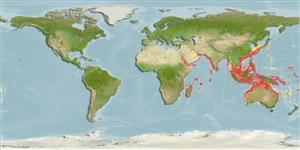Common names from other countries
Environment: milieu / climate zone / depth range / distribution range
Οικολογία
Θαλασσινό(ά); Υφάλμυρο βενθικό(ς); εύρος βάθους 10 - 400 m (Ref. 11441). Tropical; 26°C - 29°C (Ref. 4959)
Indo-West Pacific: Persian Gulf (Ref. 11441), off Pakistan, the west coast of India and Sri Lanka, Indonesia, the Philippines, Japan, and the north and east coasts of Australia.
Μέγεθος / Βάρος / Age
Maturity: Lm ? range ? - ? cm
Max length : 44.0 cm SL αρσενικό/απροσδιόριστο; (Ref. 559); common length : 30.0 cm TL αρσενικό/απροσδιόριστο; (Ref. 2872); μεγ. δημοσιευμένο βάρος: 61.90 g (Ref. 124479)
Ραχιαίες άκανθες (συνολικά) : 0; Μαλακές ραχιαίες ακτίνες (συνολικά) : 107 - 113; Εδρικές άκανθες: 0; Μαλακές εδρικές ακτίνες: 80 - 88. Eyed side brown with an irregular dark blotch on gill cover, blind side white. Blind side with 2 lateral lines (dorsal and medial). Body elongate, its depth 22 to 29% SL. Eyes with a small scaly interorbital space. Snout rounded. Rostral hook short. Corner of mouth reaching posteriorly beyond lower eye, nearer to gill opening than to tip of snout. Caudal-fin rays usually 12. Midlateral-line scales 88 to 96. Scales ctenoid on eyed side of body. Cycloid on blind side. Scale rows between lateral lines on eyed side of body 13 to 16 (Ref 9895).
Occurs in coastal areas and estuaries. May ascend upstream into the freshwater tidal zone of the Mekong (Ref. 12693). Inhabits muddy and sandy bottoms of continental shelves. Feeds mainly on benthic invertebrates (Ref. 3391). Utilized as a food fish (Ref. 3391). Marketed fresh in the Mekong delta (Ref. 12693).
Menon, A.G.K., 1977. A systematic monograph of the tongue soles of the genus Cynoglossus Hamilton-Buchanan (Pisces: Cynoglossidae). Smithson. Contrib. Zool. (238):1-129. (Ref. 5297)
IUCN Red List Status (Ref. 130435)
CITES (Ref. 128078)
Not Evaluated
Threat to humans
Harmless
Human uses
αλιεία: Εμπορικό(ά)
Εργαλεία
Special reports
Download XML
Διαδικτυακές πηγές
Estimates based on models
Preferred temperature (Ref.
115969): 16.9 - 28, mean 23.8 (based on 942 cells).
Phylogenetic diversity index (Ref.
82804): PD
50 = 0.5000 [Uniqueness, from 0.5 = low to 2.0 = high].
Bayesian length-weight: a=0.00417 (0.00262 - 0.00664), b=3.05 (2.91 - 3.19), in cm Total Length, based on LWR estimates for this species & Genus-body shape (Ref.
93245).
Τροφικό Επίπεδο (Ref.
69278): 3.9 ±0.32 se; based on food items.
Ελαστικότητα (Ref.
120179): Μεσαίο(α), ελάχιστος χρόνος για διπλασιασμό πληθυσμού 1,4 - 4,4 έτη (Fec = 2,223-225,557).
Fishing Vulnerability (Ref.
59153): Moderate vulnerability (41 of 100).
